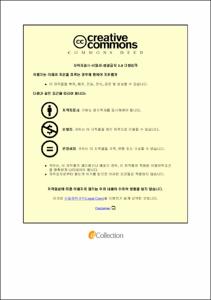액상 Ferrate(Ⅵ)를 이용한 Cyclic Compounds 분해특성 연구
- Alternative Title
- Degradation of Cyclic Compounds using Liquid Ferrate(Ⅵ)
- Abstract
- With the industry development over these last few decades, there has been an outraged increase in waste products, including toxic compounds in effluents that are highly prejudicial to human health and the environment. Amongst these is aniline is a poisonous, neurotoxin and one of the most important aromatic amines, being used as a precursor to more complex chemicals. It is widely used in various industries such as dye manufacturing, pesticides, rubber chemicals, and pharmaceuticals. Aniline is difficult to remove completely by conventional water treatment or sewage treatment, and therefore, there is a need for a method of using advanced oxidation processes (AOPs) to treat toxic organic compounds. Recently, ferrate(Ⅵ) has been studied by many researchers as an oxidizing agent that can effectively treat various kinds of pollutants. Ferrate(Ⅵ) is a hexavalent iron which can act as a strong oxidant and coagulant in the various pH range and is more oxidative than ozone, hydrogen peroxide(H2O2), and chlorine dioxide(ClO2), which are known as strong oxidizing agents in the acid condition. In this study, the stability of ferrate(Ⅵ) based on Sharma’s method and wet oxidation method and compared the degradation efficiencies of aniline in aqueous solution were investigated. Liquid ferrate(Ⅵ) synthesized by Sharma’s method has more stable than wet oxidation liquid ferrate(Ⅵ). The degradation factors were conducted at different pH, ferrate(Ⅵ) dosage, and an aqueous solution temperature. Moreover, the effect of substituent on the reaction with ferrate(Ⅵ) on the cyclic compounds such as benzene, toluene, 1,4-dioxane similar to aniline were investigated. Aniline was degraded rapidly within 30 seconds by ferrate(Ⅵ). The results indicated that the highest removal efficiency of aniline by liquid ferrate(Ⅵ) was found at acidic condition(pH 4.36). In addition, aniline removal efficiency increased with increasing of ferrate(Ⅵ) dosage, and optimum dosage considered 0.04172 mM. The optimum temperature was obtained in 25℃ of aqueous solution temperature. The intermediate analysis of aniline removal has been conducted using GC-MS. Nitrobenzene, azobenzene, and ρ-benzoquinone were identified. The decomposition rate was different depending on the functional group substituted with benzene. In case of aniline, the NH2 group is more reactive than the CH3 group and H group. Benzene and 1,4-dioxane are no significant difference in the decomposition ratio, but it is considered difficult to decompose into the oxygen atom of 1,4-dioxane.
- Issued Date
- 2018
- Awarded Date
- 2018.2
- Type
- Dissertation
- Keyword
- Aniline Ferrate Stability Degradation
- Publisher
- 부경대학교
- Alternative Author(s)
- Jung, Sun Young
- Affiliation
- 부경대학교 대학원
- Department
- 대학원 지구환경시스템과학부환경공학전공
- Advisor
- 김일규
- Table Of Contents
- 목 차 ⅰ
List of Tables ⅲ
List of Figures ⅳ
Abstract ⅵ
I 서론 1
II 이론적 배경 4
1. Aniline 4
가. 정의 및 특성 4
나. 물리화학적 특성 6
다. 인체에 미치는 영향 7
라. 처리방법 8
2. Ferrate(Ⅵ) 9
가. Ferrate(Ⅵ)의 정의 11
나. 연구동향 12
다. 수용액 상에서의 종 분포 13
라. Ferrate(Ⅵ)의 제조방법 14
3. Cyclic compounds 17
III 실험재료 및 방법 18
1. 재료 및 시약 18
2. 반응기의 구성 19
3. Stable liquid Ferrate(Ⅵ) 제조 20
4. Ferrate(Ⅵ) 분석방법 22
5. 분석방법 23
6. 중간생성물 분석 26
IV 결과 및 고찰 27
1. Ferrate(Ⅵ) 27
가. 정성 및 정량분석 27
나. 제조방법에 따른 Ferrate 자가분해 비교 28
다. 보관온도에 따른 Ferrate(Ⅵ) 안정성 30
2. 영향인자에 따른 Aniline 분해효율 32
가. Blank Test 32
나. Effect of pH 33
다. Effect of Ferrate dosage 36
라. Effect of Temperature 39
마. 활성화 에너지 42
바. 중간생성물 연구 43
3. Cyclic compounds의 분해효율 비교 46
가. Benzene derivatives 비교 46
나. Benzene, 1,4-Dioxane 비교 48
다. 반응속도 50
V 결론 52
VI 참고문헌 55
- Degree
- Master
- Appears in Collections:
- 대학원 > 지구환경시스템과학부-환경공학전공
- Files in This Item:
-
-
Download
 액상 Ferrate(Ⅵ)를 이용한 Cyclic Compounds 분해특성 연구.pdf
기타 데이터 / 1.88 MB / Adobe PDF
액상 Ferrate(Ⅵ)를 이용한 Cyclic Compounds 분해특성 연구.pdf
기타 데이터 / 1.88 MB / Adobe PDF
-
Items in Repository are protected by copyright, with all rights reserved, unless otherwise indicated.